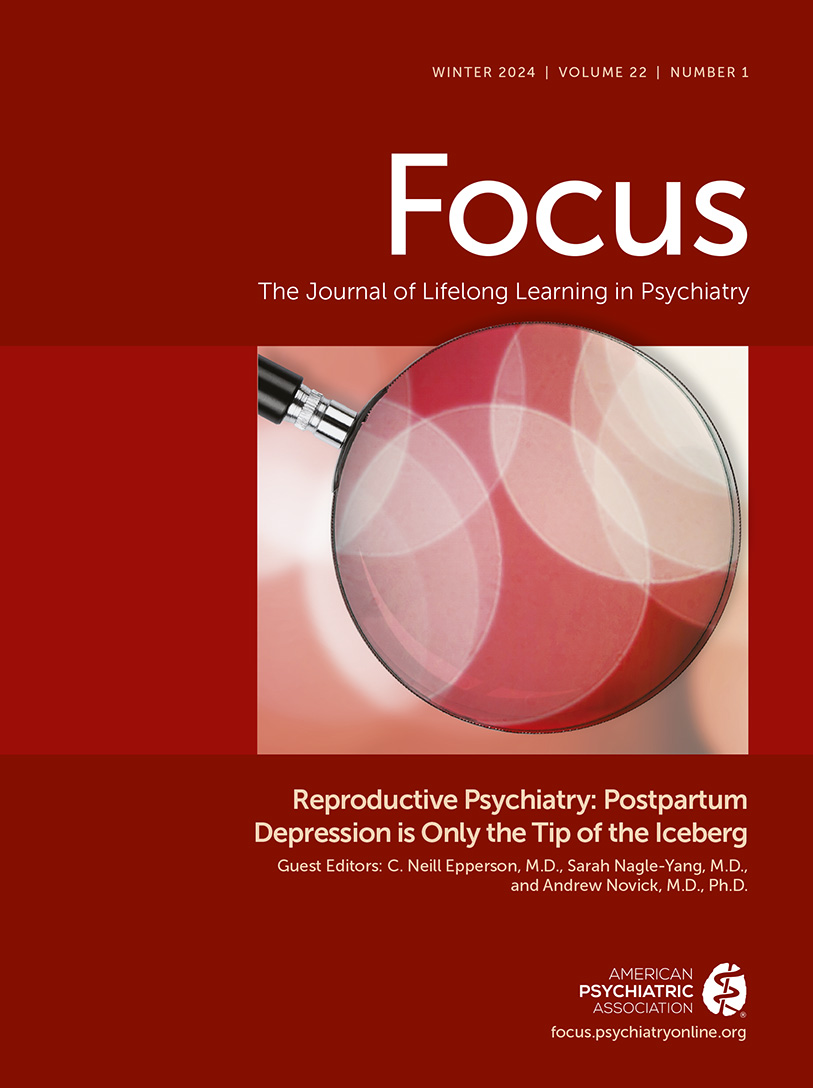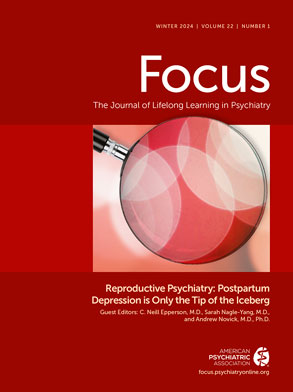Given space limitations and varying reprint permission policies, not all of the influential publications the editors considered reprinting in this issue could be included. This section contains abstracts from additional articles the editors deemed well worth reviewing.
A Scoping Review of Hormonal Clinical Trials in Menstrual Cycle-Related Brain Disorders: Studies in Premenstrual Mood Disorder, Menstrual Migraine, and Catamenial Epilepsy
Barone JC, Butler MP, Ross A, et al.
Front Neuroendocrinol (Epub ahead of print, Aug 22, 2023)
Cyclic variations in hormones during the normal menstrual cycle underlie multiple central nervous system (CNS)-linked disorders, including premenstrual mood disorder (PMD), menstrual migraine (MM), and catamenial epilepsy (CE). Despite this foundational mechanistic link, these three fields operate independently of each other. In this scoping review (N=85 studies), we survey existing human research studies in PMD, MM, and CE to outline the exogenous experimental hormone manipulation trials conducted in these fields. We examine a broad range of literature across these disorders in order to summarize existing diagnostic practices and research methods, highlight gaps in the experimental human literature, and elucidate future research opportunities within each field. While no individual treatment or study design can fit every disease, there is immense overlap in study design and established neuroendocrine-based hormone sensitivity among the menstrual cycle–related disorders PMD, MM, and CE.
Copyright 2023 Elsevier. Reprinted with permission.
Clinical Guidance for Treating Pregnant and Parenting Women With Opioid Use Disorder and Their Infants
Substance Abuse and Mental Health Services Administration. HHS Pub no SMA-18-5054. Rockville, MD, Substance Abuse and Mental Health Services Administration, 2018
This Clinical Guide provides comprehensive, national guidance for optimal management of pregnant and parenting women with opioid use disorder and their infants. The Clinical Guide helps health care professionals and patients determine the most clinically appropriate action for a particular situation and informs individualized treatment decisions.
Effect of Brexanolone on Depressive Symptoms, Anxiety, and Insomnia in Women With Postpartum Depression: Pooled Analyses From 3 Double-Blind, Randomized, Placebo-Controlled Clinical Trials in the HUMMINGBIRD Clinical Program
Epperson CN, Rubinow DR, Meltzer-Brody S, et al.
J Affect Disord 2023; 320:353–359
BACKGROUND: Brexanolone is currently the only treatment specifically approved for postpartum depression (PPD) in the United States, based on the results from one Phase 2 and two Phase 3 double-blind, randomized, controlled trials in the HUMMINGBIRD program.
METHODS: Adults with PPD randomized to a 60-h infusion of brexanolone 90 μg/kg/h (BRX90) or placebo from the three trials were included in these post hoc analyses. Data on change from baseline (CFB) in the 17-item Hamilton Rating Scale for Depression (HAMD-17) total score, HAMD-17 Anxiety/Somatization and Insomnia subscales, and Clinical Global Impression of Improvement (CGI-I) scale were pooled. Response rates for HAMD-17 (≥50% reduction from baseline) and CGI-I (score of 1 or 2) scales and time to response were analyzed.
RESULTS: Patients receiving BRX90 (n=102) versus placebo (n=107) achieved a more rapid HAMD-17 response (median, 24 vs. 36 h; p=0.0265), with an Hour-60 cumulative response rate of 81.4% versus 67.3%; results were similar for time to CGI-I response (median, 24 vs. 36 h; p=0.0058), with an Hour-60 cumulative response rate of 81.4% versus 61.7%. CFB in HAMD-17 Anxiety/Somatization and Insomnia subscales also favored BRX90 versus placebo, starting at Hour 24 through Day 30 (all p<0.05), and response rates for both subscales were higher with BRX90.
LIMITATIONS: The study was not powered to assess exploratory outcomes.
CONCLUSIONS: Brexanolone was associated with rapid improvement in depressive symptoms and symptoms of anxiety and insomnia compared with placebo in women with PPD. These data continue to support the use of brexanolone to treat adults with PPD.
Copyright 2023 Elsevier. Reprinted with permission.
Menopause and Mood: the Role of Estrogen in Midlife Depression and Beyond
Soares CN
Psychiatr Clin North Am 2023; 46:463–473
Depression is a disabling condition that often leads to significant burden. Women are more vulnerable to depression during reproductive-related “windows of vulnerability” such as the menopause transition and early postmenopausal years. This heightened vulnerability can be attributed, at least in part, to the neuromodulatory effects of estrogen on mood and cognition and the exposure to rapid fluctuations of estradiol levels during midlife years. The management of midlife depression can be challenging due to the presence and severity of other complaints such as vasomotor symptoms and sleep disturbances. Psychopharmacologic, behavioral, and hormonal interventions should be part of the treatment armamentarium.
Copyright 2023 Elsevier. Reprinted with permission.
Pharmacotherapy for Depression and Bipolar Disorder During Lactation: A Framework to Aid Decision Making
Sprague J, Wisener KL, Bogen DL
Semin Perinatol 2020; 44:151224
OBJECTIVE: Breastmilk is recommended as the exclusive source of nutrition for infants younger than 6 months due to the numerous health benefits for both infants and mothers. Although many women are prescribed medications during pregnancy and postpartum, limited data are available to assist women in weighing the benefits compared to the risks of peripartum medication use. The goals of this paper are to discuss the importance of breastmilk for the health of both the mother and infant, evaluate the impact of medication use on women’s infant feeding choice, describe the transfer of drugs to breastmilk and infants, and provide a framework for clinicians to support evidence-based counseling for women treated for mood disorders.
RECOMMENDATIONS: We recommend early pregnancy counseling to discuss the benefits and risks of medications during breastfeeding. The Surgeon General’s Call to Action (2011) highlights the short and long-term negative health effects of not providing breastmilk. Integrating recommendations from the pediatric and obstetric teams allows patients to make decisions based on evidence and reach their infant feeding goals. Databases containing summaries of research findings and pharmacologic properties of the drug of interest are an essential resource for clinicians.
Copyright 2023 Elsevier. Reprinted with permission.

